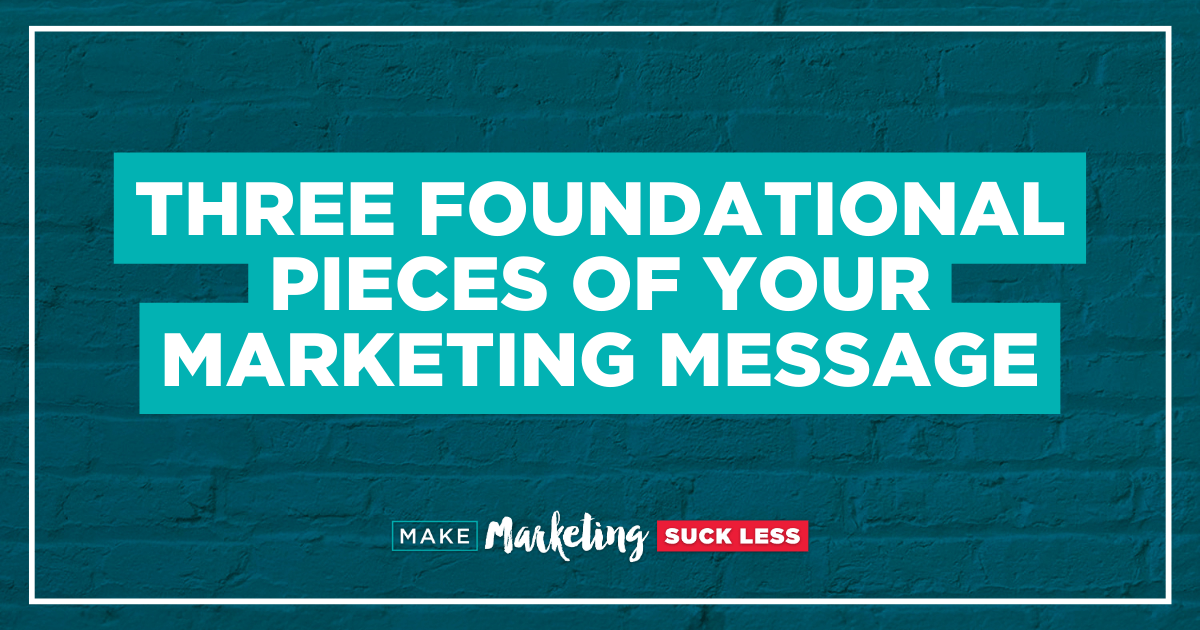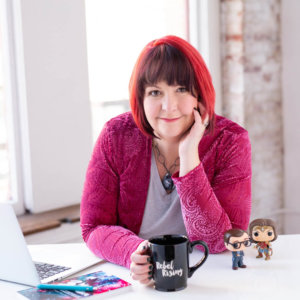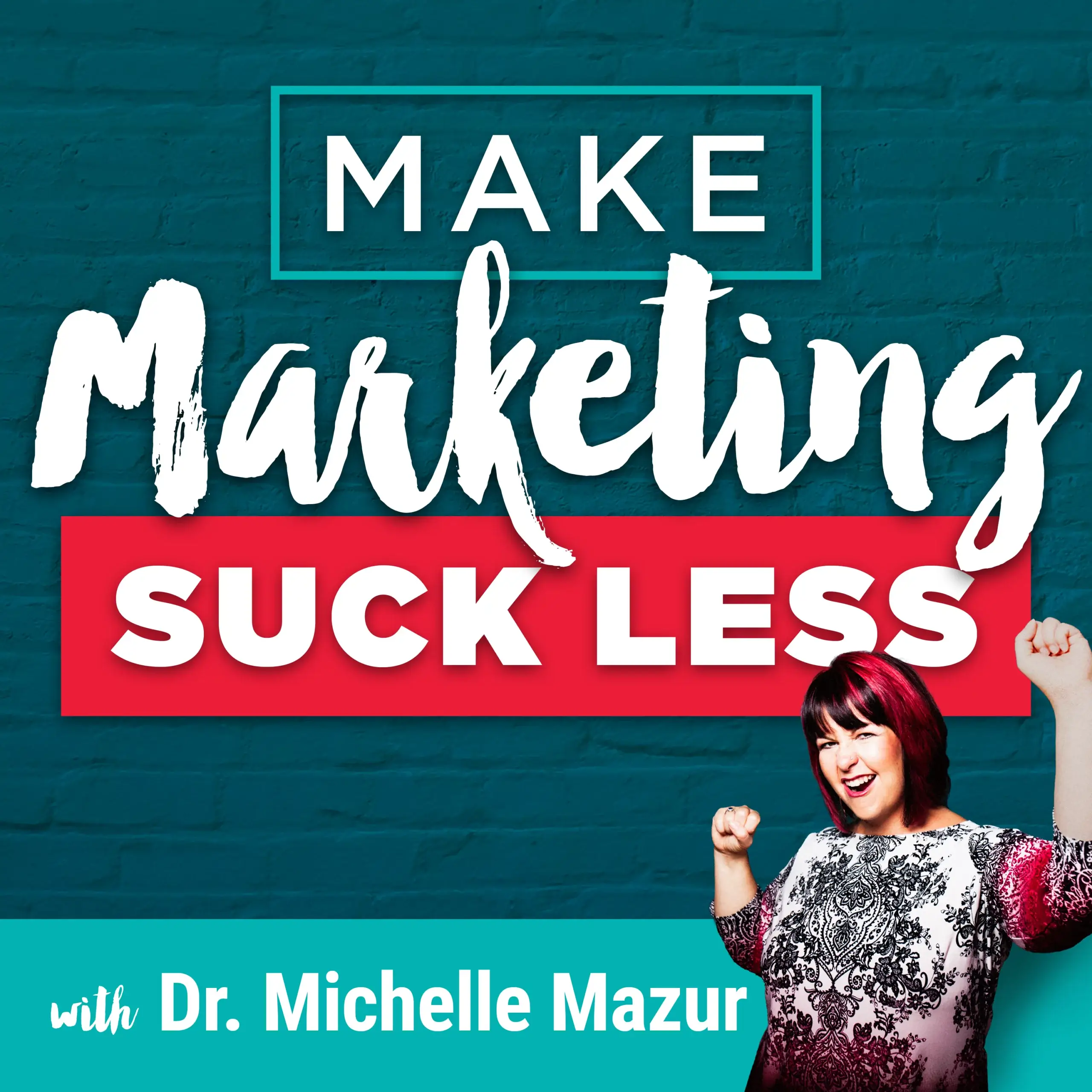Make Marketing Suck Less
3 Foundational Pieces of Your Marketing Message
By Michelle Mazur > October 17, 2023
Filed Under Podcast

There's something celebrity online marketers get wrong about marketing messaging all the time.
They teach you that messaging is just one simple thing, like, it's an elevator pitch, your unique selling proposition, a content plan, or your client avatar.
It’s not.
If you've been a fan of the show for a long time, you know that your marketing message is literally everything your business communicates.
Whether it's in marketing, on your website, in sales conversations, and even when you're being interviewed on podcasts or asked to speak on a stage, it’s ALL messaging.
It's a huge foundational area of your business to work on. I know that can feel overwhelming to create.
It can feel like you just don't know where to start, so you put it off..
That's why on today's pod, I wanted to tell you exactly where to start. We're going to talk about 3 foundational pieces of messaging to focus on first so you can make your marketing more effective straight away.
(Click play or read the transcript below.)
In this episode:
- The alternative to pain point marketing
- Why bad messaging actually costs your business
- The three key pieces of messaging to focus on first for more effective marketing are micro-stories, problem statements, and why-buy statements.
Learn more about Michelle Mazur:
Resources:
Listen on your favorite podcast player or read the Transcript below:
Michelle Mazur [00:00:00]: There's something celebrity online marketers get wrong about messaging all the time. They teach you that messaging is just one simple thing, like, it's an elevator pitch, your unique selling proposition, a content plan, or your client avatar. And if you've been a fan of the show for a long time, you know that messaging is literally everything your business communicates in its marketing, on your website, in sales conversations, and even when you're being interviewed on podcasts or asked to speak on a stage. It's a huge foundational area of your business to work on. And I know - that can feel overwhelming. It can feel like you just don't know where to start, so you just kind of put it off for a while. That's why on today's pod, I wanted to tell you exactly where to start. We're going to talk about 3 foundational pieces of messaging to focus on first so you can make your marketing more effective straight away. So let's dive in. Michelle Mazur [00:02:12]: Before we dive in on where to start, I think it's important to talk a bit about the high cost of bad messaging. I'm not doing this to scare you, but messaging is like electricity in our businesses. It's an invisible current that runs through your entire business from the time someone first discovers you, to the minute that they get on your email list, to the second they sign up for a sales conversation. And it even runs through your delivery process. But unlike electricity, when you know there's a problem with it because nothing works in your house, your refrigerator doesn't work, the TV doesn't turn on, you lost your internet. But messaging can be sneaky. It's not as obvious as electricity. Sometimes we don't know that the message is actually the problem in our business. So let's talk a little bit about what your messaging not working actually costs your business. So the first one is the most obvious, right? There's a revenue cost to poor messaging, namely clients, right? We're not attracting the clients that we want to attract, or we're attracting people, but they're not quite the right people. Maybe we're not meeting our revenue goals. We're not attracting the clients that we want to attract, or we're attracting people, but they're not quite the right people. Maybe we're not meeting our revenue goals. And we're also spending money on marketing that might not work for you because you don't have the foundation of the message. I mean, that's something I've seen again and again in my business where people hire this big-time marketing agency to build them out this funnel and all of these marketing assets, and, oops, it doesn't work because the message isn't where it needs to be, so there is a revenue cost to our messaging not being dialed in. Michelle Mazur [00:04:22]: Second, there's an opportunity cost, like, opportunities to share your expertise, to build that audience of future buyers, to be referable by the clients who love you. When we don't know how to talk about our business in a compelling way. It's really hard to get those opportunities because people just don't know what we're about, what we stand for, what we do, and what makes us unique. And so you find yourself in that situation shun of getting passed over or the client who loves you refers someone, and they're like, I don't know what this person does. Why should I be interested in this again? So there's that opportunity cost of being able to share our expertise and to be referable. And then finally, time. The energy you put into marketing is immense. On the last podcast, I was talking about how business owners no. Michelle Mazur [00:05:29]: It wasn't the last podcast. On the podcast about business owners versus creators, I was talking about how business owners have to juggle client delivery with marketing, with sales. We have a lot of balls up in the air, and we can't afford to waste time on marketing that's not gonna work for our business because then we're not building out the assets. So messaging is a great way to mitigate some of these costs and let you capitalize on clients more unity and save time when that message is dialed in. I know you kinda hate marketing, but to make marketing suck less, to make it more effective. You need to know what to say so that you can create those assets again and again. This is a huge topic, so let's dive into the 3 foundational pieces of messaging for your business. So this is not all the messaging you need, but it's a solid start to chip away at that huge chunk of unformed marble known as your messaging. Michelle Mazur [00:06:49]: So the 3 foundational pieces we're going to talk about are micro-stories for empathy and connection, the problem statement, and the why-by statement. And by the way, if you want to create these statements with me in a place where you can get my feedback and input on your business's marketing message. The Nail Your Message workshop is coming back the week of October 23rd. You can sign up for it right now at drmichellemazur.com/nail. It's $150, and during that week, you're going to get these 3 foundational pieces handled. So let's talk about them. The 1st foundational piece is the micro story. Michelle Mazur [00:07:39]: Micro-stories are an alternative to pain point marketing. I know that you don't want to press on people's pain points. That feels icky because when we are agitating somebody's pain, we're kind of shaming and blaming them. It makes them feel like shit, and that's not the way we want to do marketing. But if you're telling micro-stories about their experience. You're acknowledging their reality and empathizing with it. And I know that this is such a subtle difference because there are some people who are like, don't talk about pain points at all, but that's like spiritual bypassing, right? It's like there's something wrong in a person's life and you should acknowledge it. Michelle Mazur [00:08:33]: It's like if you saw a person with a broken leg, you wouldn't think that everything is right for them, that they're feeling great, they're 100%. No. You would acknowledge it. You would ask them how they are doing, what they need help with, like, feeling that empathy, acknowledging, like, hey, this sucks for you. That broken leg sucks. Whereas pain point marketing is seeing the broken leg, walking up to that person, kicking them in the broken leg until they pay you to stop. That's the difference, and micro-stories can really give a richness to your potential clients experience so that they see themselves in the story you're telling, but more like, oh, it's not just me, or, oh, that's me. I'm not alone, which is a different experience. Micro stories are specific and not vague. So most of the time when people address pain points, they're super vague. So they'll say something like, y You're overwhelmed. Great. Overwhelm can mean a million different things for each person. Right? Like, a mom who's overwhelmed looks really different from a business owner who has more clients than they can handle and things are falling through the cracks. Right? Do you see how specific that is? And you can even dive in a little deeper, that idea of, like, one of the ways overwhelm shows up for me. Like, I wake up in the middle of the night, and my to do list starts running through my head, and I just feel that impending sense of dread for the day ahead because there's so much to do and I don't know where to start. That's a specific micro-story. It's acknowledging the experience. And the great thing is you can have multiple micro stories that you're telling. So you wanna build these as micro-stories from insights you have about your clients. You need to understand the people you serve and how something is showing up for them. Because micro-stories, what they're great at is getting clients' attention, making them feel seen and heard, and then they want to know more. And the cool part is you can use these micro-stories in so many different places, on your sales page, your home page, social media posts, in email marketing. Anywhere you need to be marketing, you can start telling micro-stories. Michelle Mazur [00:11:38]: Now that we've talked about micro stories, let's move on to the second foundational piece of messaging, which is the problem statement. Specifically, we need to dive in deeper on the problem we solve and look at it from different angles. I saw a post the other day about how Toyota approaches problems in their organization, and they do that by becoming obsessed with the problem. They study it. They look at it from different angles. They think about all the different solutions. Because, here's the deal with problems is that in some ways, one problem could have multiple solutions. Let's look at the problem of not making enough money in your business. You might have a sales problem. You might have a lead generation problem. You might have an offer that nobody wants. You might not be very good at sales. There's a lot of different reasons why you're having the problem you're having, and it's your job as the marketer to help that person figure out what flavor of problem they have. Let me say that again. It is your job as a marketer to help your person figure out what flavor of problem they have and decide, oh, this is the right solution for me. Now I see two big problems with problems. The first is how people define problems in terms of their solution. So I'm a goal-setting coach, and your problem is you don't have goals. No. Not having goals is not the problem. There is another deeper problem of what not having goals is driving. The second is being super vague about the problem you solve. Right? So we'll go back even to the micro-story example of overwhelm. Maybe you solve a problem of overwhelm, but what does that actually mean? How does it impact the person? When I teach problems in the Nail Your Message workshop, we look at problems on 3 different levels. The 1st level is the presenting problem. This is the thing people come who you with. They tell you that they have this problem. So one big presenting problem for my 1 on 1 clients is they created a group program or they want to have a group program, and they don't have an audience to launch it to or they don't have enough people to launch it to. So that's kind of the presenting problem. And then that problem actually has impacts. It's a ripple effect. So that's the 2nd layer of the problem. Like, what are the ripple effects? And then figuring out what is the actual root cause. So in the Nail Your Message workshop, we're going to dig into all 3 levels so that you can create a problem statement that is clear, that helps your right client identify. Okay. Yeah. I have this problem or I don't. Michelle Mazur [00:15:26]: The final piece of messaging you should work on is the why buy statement. Outside of the 3 Word Rebellion, this is one of my favorite pieces of messaging to create because it is so versatile. So the why buy statement is one sentence which presents the most compelling reason to work with you. And the amazing part of why buy statements is that you can have one for your overall business. You can have one for each of your offers. You can have one for your newsletter, for your lead magnet. Once you know how to create a why buy statement you can promise without overpromising. Now in the online space, most of the web celebs overpromise. Like, one program promise I saw was add 6 figures of revenue to your business. A promise like that is actually not in the service provider's control to deliver on. There's a lot of factors that determine if you can add 6 figures of revenue. And taking a course or a program on that is a teeny tiny factor. So we don't want to overpromise and underdeliver, that leads to unsatisfied clients and a bad reputation in the industry. Michelle Mazur [00:17:13]: So you want to promise things that you can control, and at the same time, your clients can benefit from and want. So here's a couple of examples from my own business. So for my 1 on 1 work, my why buy statement is communicate the value your business creates, whether you're talking to 1 person or a million. So great. I'm gonna get them very clear on the value proposition for their business and how to talk about their business, and it doesn't matter if they're in a 1 on 1 conversation or they're broadcasting it to the world. For the Nail Your Message workshop, it's craft 3 foundational pieces of messaging to explain what the fuck you do and why it matters to the people who need to hire you. So the benefit is really clear, and the best part is, like, those things are in my control. I can help you communicate the value. I can help you craft 3 foundational pieces of messaging. And it's also rooted in a benefit so that people know what they get. And the cool thing is this is like a little mini elevator pitch for your offers that makes your work enticing. It makes people want to know more about your work. So those are the 3 pieces of messaging that you should start with to chip away at this unformed marble that is your message. And I know it's a huge topic. It can feel overwhelming to even think about getting started on it. But it's important that you do get started. You can make a dent and get more clarity and be more confident in your marketing when you have these 3 pieces. Michelle Mazur [00:19:25]: If you want my help, the Nail Your Message workshop is the place to be. We are enrolling now, and and the workshop takes place on October 23rd, 25th, and 26th at 10 AM Pacific time, 1 PM Eastern. Sessions last about an hour, and the majority of the time in the workshop shop will be spent on you doing the work of messaging and getting my feedback so that you can leave and have more confidence in your marketing message and just have these 3 pieces of messaging handled. If you're interested in the Nail Your Message workshop, please join us at drmichellemazur.com/nail. I'd love to see you there and support you in getting greater clarity and confidence around your marketing message. Michelle Mazur [00:20:29]: If the Make Marketing Suck Less pod is making your marketing more effective so that your clients can find and hire you, please share the show with a friend. The easiest way to do that is through podlink. You can find the show at pod.link/rebel, and that page will allow anyone you share the show with to subscribe and start listening in their favorite podcast player. That's pod.link/rebel. The Make Marketing Suck Less podcast is a production of Communication Rebel. Our production coordinator is Jessica Gulley-Ward. The podcast is edited by Steven Mills, executive producer is me, Dr. Michelle Mazur. The make marketing suck less podcast is recorded on the unseated traditional lands of the coast salish peoples, specifically the first people of Seattle, the Duwamish people, original stewards of the land, past, and present all.
Enter your name and email address below and I'll send you periodic updates about the podcast.
Sign up to receive email updates
Create Your One-of-a-Kind Message
Your 3 Word Rebellion is the Key to Growing Your Business & Impact






